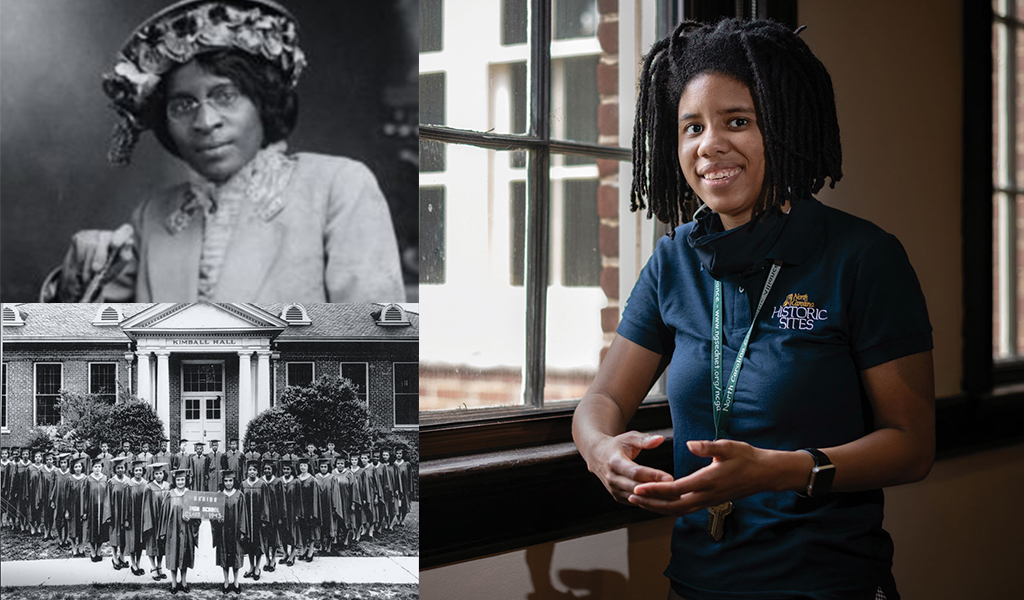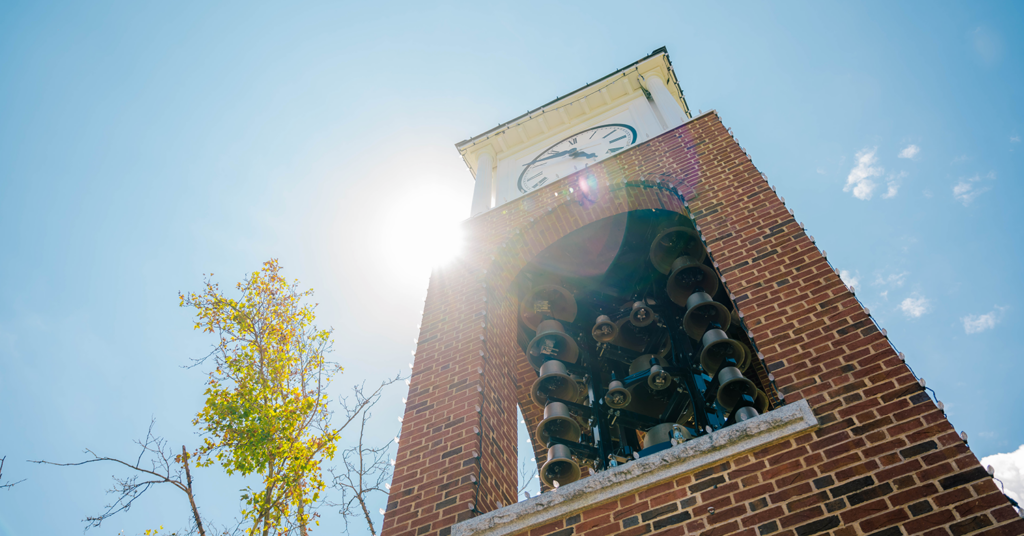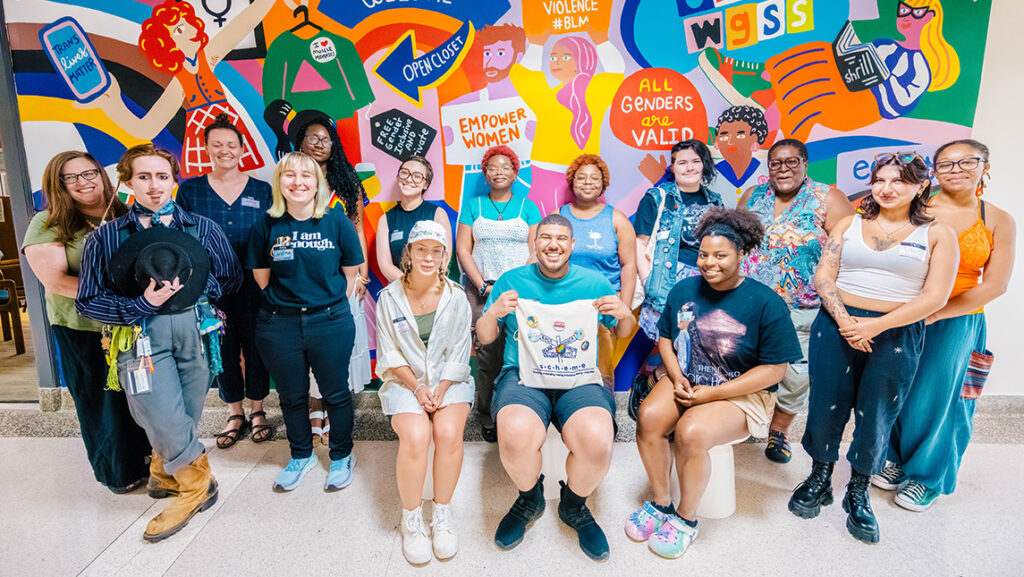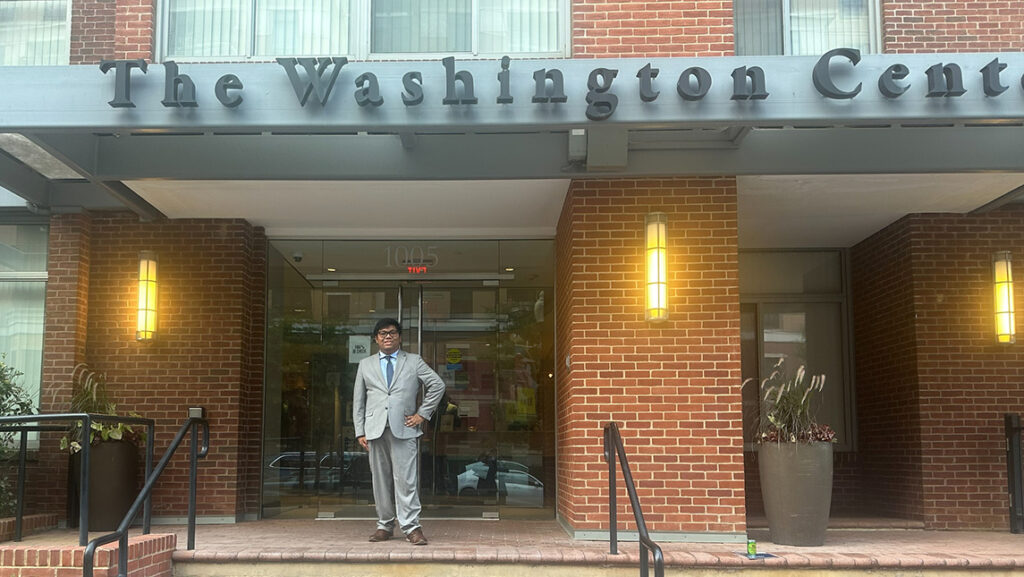
Off a busy, rural road in Gibsonville, North Carolina, stands the one state historic site in North Carolina focusing on African American history – and the only one honoring a woman.

Brick dormitories, pastel teachers’ cottages, and a school bell mark what was once the Palmer Memorial Institute, a 20th-century boarding school where more than 2,000 African American high schoolers had the rare opportunity to earn a “New England education” in the heart of the South.
The boarding school was opened in 1902 by a headstrong young educator, Dr. Charlotte Hawkins Brown, when she was only 19 years old. From its humble beginnings in a blacksmith’s cabin, it grew to include 200 acres and to produce professors, lawyers, and politicians who would go on to change history in their own ways.
This school was Dr. Brown’s life’s mission.
Today, three young women – all graduates of UNC Greensboro’s museum studies master’s program – are continuing that mission in their own way. As the small but mighty staff of what is now the Charlotte Hawkins Brown Museum, these UNCG alumni are dedicated to sharing a piece of history that is often overlooked – or in this case, driven past.
Yet for those who take the time to stop, to walk the museum’s peaceful acres and listen to the story of Dr. Brown and her school, what they will find is a history that resonates with startling relevance today.
A new model of education
Agriculture or manual labor training? As an African American at the turn of the 20th century, these were your typical options if you wanted to continue your education.
“Segregated schools in the South were also in horrible condition at the time,” said Leslie Leonard ’17 MA, the museum’s assistant site manager.
Yet having earned an integrated education in Cambridge, Massachusetts, Brown – the granddaughter of slaves – was insistent on offering a liberal arts education to African Americans in rural North Carolina.
“Her education model was really unique,” Leonard said. “You could concentrate in areas like visual arts or dance which, for African Americans in the early 1900s, was pretty much unheard of.”
The school was also the first in Guilford County to teach African American history and sexual education.


Lured by this new model, Palmer Memorial Institute attracted some notable names. Poet Langston Hughes guest-lectured in the English department. Lula Martin McIver, widow of Woman’s College (now UNCG) founding president Charles Duncan McIver, was active on the board and a frequent donor.
Some Woman’s College alumni may even recall the Sedalia Singers, the institute’s traveling choir, singing at chapel sessions. Music was important at the institute, and the ensemble would tour to help Dr. Brown in fundraising.
By all accounts, Brown’s new education model was a success. A 1960s stat showed 98% of Palmer’s graduates went on to receive bachelor’s degrees, and 64% of them pursued their education to at least one graduate degree.
Rules to live by
The school’s success can be pinned almost entirely on one person: the museum’s namesake. Though small in stature, Dr. Charlotte Hawkins Brown was a force to reckon with.
“I would have been terrified of her, while also wanting to be around her all the time,” said Sonya Laney ’17 MA, the museum’s education coordinator.

Dr. Brown was also notoriously strict. Her book on etiquette is 148 pages long and very specific. She once kicked A.D. King – the younger brother of Martin Luther King, Jr. – out of her school because a photograph showed him with his eyes open during prayer.
That’s because she knew that etiquette, for African Americans, wasn’t just about plates and knowing how to dress. It was about survival.
“Being Black in the South, you could get lynched for anything at that time,” said Lacey Wilson ’18 MA, the museum’s site manager.
Knowing proper etiquette also allowed you to be in rooms where important decisions were made. Brown was fiercely devoted to political advocacy. She served on women’s voting groups and regularly spoke out against racial and social inequities.
She adamantly opposed segregation, which caused conflict with Woman’s College chancellor Walter Clinton Jackson. In 1935, she wrote to Jackson requesting to purchase 50 tickets for her students to attend a musical performance at Aycock Auditorium (now UNCG Auditorium). However, citing the state’s political and social pressures of the time, Jackson stated he could only offer her students segregated upper-balcony seating.
Initially Brown declined the offer, but two years later, requested the seats again. She wanted her students to experience fine music, declaring in her letter to Jackson, “We are going to listen to the music, feed our souls and then walk out of the auditorium just as fine in body and soul as we would have had not the laws of North Carolina segregated us.”
Brown expected her students to carry this same passion for change.
“Charlotte was all about showing her students how to succeed in this world, while fighting back against the things you don’t like,” Wilson said. “When they finished their education, it was their time to go and uplift other members of society.”
History made relevant

The Palmer Memorial Institute closed its doors in 1971. Its end was brought on by a combination of factors: a building burned down, public schools desegregated, and boarding schools were no longer in fashion. Perhaps most critically, Dr. Brown died.

Yet her passion for the school continues today, now in the hands of three young UNCG alumni. Together they give tours, organize educational events, and maintain the archives.
More than preserving Dr. Brown’s legacy, however, they’ve taken on a new mission: to make the museum’s history unequivocally relevant to the issues and audiences of today. Wilson, the new site manager, has added fervor to this mission. She joins the museum after working as a historic interpreter at the Owens-Thomas House and Slave Quarters in Savannah, Georgia.
“Yes, we are a museum,” Wilson said. “Yes, we are a historic site. But we also want to be more of a community center, a place where people can come for events that fit what the community needs as well.”
They plan to turn the museum into an early voting site, create a Black businesses market, and schedule pop-up exhibits around topical events – all of which can be connected to Dr. Brown’s extensive social activism.

This year has given them plenty of practice making history fit the contemporary climate. Especially during COVID-19, they have been utilizing social media in creative ways, both to offer virtual tours and connect with new generations. When George Floyd was killed by Minneapolis police, they turned to Dr. Brown’s speeches against police bias as a teaching tool.
They say UNCG’s museum studies program, with its many hands-on projects and field trips, is where they really honed their ability to help visitors connect with history in meaningful ways.
“We’re lucky enough to be at a place where we can talk about relevant issues that speak to what’s going on in society, where we can dissect history and give it to people in a really relevant way,” said Leonard. “It makes the work we’re doing even more meaningful.”
By Elizabeth Keri, for UNCG Magazine
Contemporary photography by Martin W. Kane. Archival photography courtesy the Charlotte Hawkins Brown Museum.






